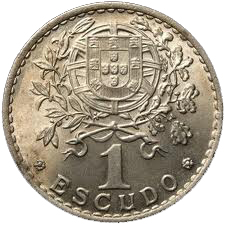|


The escudo (Portuguese pronunciation: [ɨʃˈkuðu], shield; sign: \mathrm{S}\!\!\!\Vert ; code: PTE) was the currency of Portugal prior to the introduction of the Euro on 1 January 1999 and its removal from circulation on 28 February 2002. The escudo was subdivided into 100 centavos.
Amounts in escudos were written as escudos$centavos with the cifrão as the decimal separator (e.g. 25$00 means 25 escudos, 100$50 means 100 escudos and 50 centavos). Because of the conversion rate of 1000 réis = 1 escudo, three decimal places were initially used (1 escudo = 1$000).
History
The escudo was introduced on 22 May 1911, after the 1910 Republican revolution, to replace the real at the rate of 1,000 réis to 1 escudo. The term mil réis (thousand réis) remained a colloquial synonym of escudo up to the 1990s. One million réis was called one conto de réis, or simply one conto. This expression passed on to the escudo, meaning 1,000 escudos.
The escudo's value was initially set at 4$50 escudos = 1 pound sterling. After 1914, the value of the escudo fell, being fixed in 1928 at 108$25 to the pound. This was altered to 110$00 escudos to the pound in 1931. A new rate of 27$50 escudos to the U.S. dollar was established in 1940, changing to 25$00 in 1940 and 28$75 in 1949.
Inflation throughout the 20th century made centavos essentially worthless by its end, with fractional value coins with values such as $50 or 2$50 eventually withdrawn from circulation in the 1990s. With the entry of P+ortugal in the Eurozone, the conversion rate to the euro was set at 200$482 escudos to €1.
Territorial usage
The escudo was used in the Portuguese mainland, the Azores and Madeira, with no distinction of coins or banknotes. In Portugal's African colonies, the escudo was generally used up to independence, with Portuguese and sometime local coins circulating alongside banknotes of the Banco Nacional Ultramarino, rather than those of the Bank of Portugal used on the mainland. For more details, see the escudos of Angola, Cape Verde, Mozambique, Portuguese Guinea and São Tomé and Príncipe. Only Cape Verde continues use the escudo. In Macau, the currency during the colonial period was, as it is today, the pataca. Timor-Leste adopted the escudo whilst still a Portuguese colony, having earlier used the pataca. Portuguese India adopted the escudo before it was annexed by India.
Coins
Between 1912 and 1916, silver 10, 20 and 50 centavos and 1 escudo coins were issued. Bronze 1 and 2 centavos and cupro-nickel 4 centavos were issued between 1917 and 1922.
In 1920, bronze 5 centavos and cupro-nickel 10 and 20 centavos were introduced, followed, in 1924, by bronze 10 and 20 centavos and aluminium bronze 50 centavos and 1 escudo. Aluminium bronze was replaced with cupro-nickel in 1927.
In 1932, silver coins were introduced for 2½, 5 and 10 escudos. The 2½ and 5 escudos were minted until 1951, with the 10 escudos minted until 1955 with a reduced silver content. In 1963, cupro-nickel 2½ and 5 escudos were introduced, followed by aluminium 10 centavos, bronze 20 and 50 centavos and 1 escudo in 1969. Cupro-nickel 10 and 25 escudos were introduced in 1971 and 1977, respectively. In 1986, a new coinage was introduced which circulated until replacement by the euro. It consisted of nickel-brass 1, 5 and 10 escudos, cupro-nickel 20 and 50 escudos, with bimetallic 100 and 200 escudos introduced in 1989 and 1991.
Coins in circulation at the time of the changeover to the euro were:
* 1 escudo (.50 cent)
* 5 escudos (2.49 cent)
* 10 escudos (4.99 cent)
* 20 escudos (9.98 cent)
* 50 escudos (24.94 cent)
* 100 escudos (49.88 cent)
* 200 escudos (99.76 cent)
Coins ceased to be exchangeable for euro on December 31, 2002.
Another name for the 50 centavos coin was coroa (crown). Long after the 50 centavos coins disappeared, people still called the 2$50 coins cinco coroas (five crowns).
Also, people still referred to escudos at the time of the changeover in multiples of the older currency real (plural reis). Many people called the 2$50 coins dois e quinhentos (two and five-hundreds), referring to the correspondence 2$50 = 2500 reis. Tostão (plural tostões) is yet another multiple of real, with 1 tostão = 10 reis.
Banknotes
The Casa da Moeda issued notes for 5, 10 and 20 centavos between 1917 and 1925 whilst, between 1913 and 1922, the Banco de Portugal introduced notes for 50 centavos, 1, 2½, 5, 10, 20, 50, 100, 500 and 1000 escudos. 50 centavos and 1 escudo notes ceased production in 1920, followed by 2½, 5 and 10 escudos in 1925 and 1926. 5000 escudos notes were introduced in 1942.
The last 20 and 50 escudos notes were printed dated 1978 and 1980, respectively, with 100 escudos notes being replaced by coins in 1989, the same year that 10,000 escudos notes were introduced
Banknotes in circulation at the time of the changeover to the euro were:
* 500 escudos (€2.49)
* 1000 escudos (€4.99)
* 2000 escudos (€9.98)
* 5000 escudos (€24.94)
* 10,000 escudos (€49.88)
Banknotes can still be returned to the central bank Banco de Portugal and converted to euros until 28 February 2022.
Escudo banknotes celebrated notable figures from the History of Portugal. The final banknote series featured the Age of Discovery, with João de Barros, Pedro Álvares Cabral, Bartolomeu Dias, Vasco da Gama, and Henry the Navigator.
The last 100-escudo Banknote represented Fernando Pessoa, the famous Portuguese writer.
Colloquial expressions
"Conto" was the unofficial multiple of the escudo: 1 conto meant 1000$00, 2 contos meant 2000$00 and so on). The original expression was "conto de réis", which meant "one million" réis. Since the escudo was worth 1000 réis (the older currency), therefore one "conto" was the same as a thousand escudos.
The text on this page has been made available under the Creative Commons Attribution-ShareAlike License and Creative Commons Licenses
| 